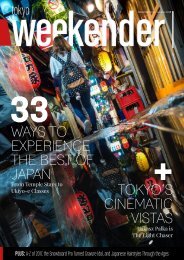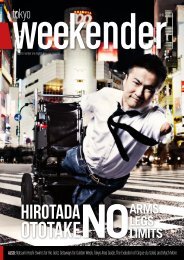Tokyo Weekender July 2016
Breaking the rules of kimono – a new book shatters antiquated views of this traditional garment. Plus: The boys for sale in Shinjuku Ni-chome, best sake of 2017, Japan's new emperor, and what really goes on inside "Terrace House."
Breaking the rules of kimono – a new book shatters antiquated views of this traditional garment. Plus: The boys for sale in Shinjuku Ni-chome, best sake of 2017, Japan's new emperor, and what really goes on inside "Terrace House."
Create successful ePaper yourself
Turn your PDF publications into a flip-book with our unique Google optimized e-Paper software.
The Web<br />
has also helped<br />
create a medium<br />
for homegrown<br />
kimono influencers<br />
who reside<br />
outside of Japan’s<br />
bigger cities. One<br />
in particular,<br />
Akira Times [who<br />
created the image<br />
on this issue's<br />
cover], breaks the<br />
mold of the image<br />
of the traditional<br />
kimono wearer.<br />
He says people are<br />
looking for culture<br />
in the wrong places<br />
because they<br />
are looking to the<br />
past and trying to<br />
preserve it, rather<br />
than making<br />
something new. He believes in breaking stereotypes<br />
and taboos to create something that<br />
never existed before. He and Cliffe agree<br />
that revising how people frame the kimono<br />
is critical for it to remain a fashion item in<br />
the future, and the Internet is one way to<br />
help spread knowledge and style ideas.<br />
However, even with all the knowledge<br />
online, some things still get lost in translation.<br />
For Cliffe’s book, she interviewed 50 international<br />
kimono wearers and 50 Japanese kimono<br />
wearers. The difference in their collections<br />
was remarkable. While Japanese enthusiasts<br />
had wardrobes with raw silk and komon (a<br />
casual kimono with all-over patterns) for<br />
everyday wear, international wearers had<br />
completely different collections. “They had<br />
so many gorgeous kimono, but they were<br />
very formal and with very few uses for them.<br />
I understand why, though. They’re coming<br />
from the outside, from a visual aspect, and<br />
those are the ones that make the strongest<br />
impression. I wanted to show that Japan has<br />
always had its<br />
own fashion,<br />
unrelated to the<br />
West. I wanted to<br />
tell the users’ and<br />
wearers’ story.<br />
The international<br />
wearers only<br />
have part of that<br />
story, through<br />
photos and websites<br />
with geisha<br />
on them. If you’re<br />
going to have a<br />
photo taken, then<br />
you wear a fancy<br />
kimono and that<br />
creates a distortion<br />
in the data.<br />
I wanted to tell<br />
the real stories of<br />
real women.”<br />
This was<br />
how Cliffe’s bilingual<br />
project, Kimono Closet, was born.<br />
This ongoing project catalogues women’s<br />
kimono wardrobes as well as their stories<br />
behind certain kimono, their influences,<br />
and their challenges. For Cliffe, her social<br />
study of kimono has only just begun.<br />
The Social Life of Kimono is available on<br />
Amazon.co.jp for ¥3,226. For more info<br />
about Dr. Sheila Cliffe and her projects, visit<br />
www.kimonocloset.com. Also, find her on<br />
Instagram: @kimonosheila and YouTube:<br />
Kimono World.<br />
WHERE TO BUY<br />
& HOW TO WEAR<br />
While the media would have us believe<br />
the kimono industry is dying, Cliffe<br />
insists this isn’t the case. “There are<br />
some kimono that are only made in<br />
certain places because of the weather<br />
or because the techniques are so<br />
exacting that only a few older people<br />
remember how to do it. Those types are<br />
endangered, but kimono isn’t dying.<br />
It’s changing. There are a lot of new<br />
and successful businesses out there. It’s<br />
fashion, and fashion changes. There’s<br />
nothing wrong with that.” So, where to<br />
get your kimono kicks in <strong>Tokyo</strong>? Here<br />
are three recommended spots…<br />
GALLERY KAWANO<br />
Extensive selection of vintage kimono,<br />
obi and haori (jacket), with sizes<br />
available to suit the taller shopper.<br />
Flats Omotesando 102, 4-4-9 Jingumae,<br />
Shibuya-ku, www.gallery-kawano.com<br />
KIMONO, REMADE: TOKYO<br />
KALEIDOSCOPE<br />
For those who love kimono patterns<br />
and fabrics but aren’t keen on the<br />
traditional way of wearing them, Lia<br />
makes stunning modern-day bespoke<br />
creations from vintage kimono.<br />
www.tokyokaleidoscope.com<br />
HISUI TOKYO<br />
This school offers lessons not only in<br />
kimono dressing, but also tea ceremony,<br />
calligraphy and sword training in the<br />
heart of Ginza. 5F Koizumi Bldg., 4-3-13<br />
Ginza, Chuo-ku, en.hisui-tokyo.com
















